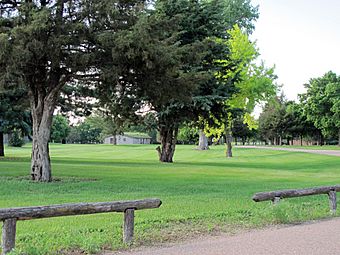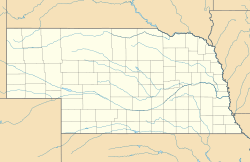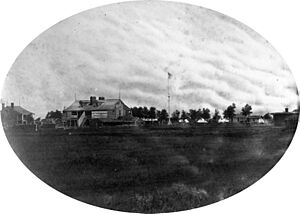Fort Kearny facts for kids
Quick facts for kids |
|
|
Fort Kearney
|
|

Restored Fort Kearny State Park
|
|
| Nearest city | Newark, Nebraska |
|---|---|
| Area | 80 acres (32 ha) |
| Built | 1848 |
| NRHP reference No. | 71000485 |
| Added to NRHP | July 2, 1971 |
Fort Kearny was an important army outpost in the United States during the 1800s. It was built in 1848 and named after General Stephen Watts Kearny. The fort was located in what is now Nebraska, near the famous Oregon Trail. The nearby town of Kearney got its name from the fort. A small part of the original fort is now a park called Fort Kearny State Historical Park.
This fort was a key stop for people traveling west. It was like a rest stop and supply store for wagon trains for about 20 years. Travelers could get fresh supplies and trade their animals. It was a safe place in a new and sometimes dangerous land. Over time, the fort grew to have more than 30 buildings. It also became a station for the Pony Express, Overland Stage, and a telegraph station.
Contents
Why Fort Kearny Was Built
Fort Kearny was built because many people started moving west to Oregon after 1845. The first version of the fort was set up in the spring of 1848. It was near the Platte River and was first called Fort Chiles. Later that year, it was renamed Fort Kearny to honor General Stephen Watts Kearny.
In 1848, an important agreement was made at Fort Kearny. The Pawnee Nation and the U.S. government signed a major treaty there. A skilled interpreter named Jeffrey Deroine helped with the talks.
Fort Kearny's Many Jobs
Even without strong walls, Fort Kearny did many jobs. It was a stopping point, a guard post, a supply center, and a message hub. Many people heading to California and the Pacific Northwest relied on it. Early photos from 1858 show the fort as a group of simple buildings without walls. By the 1860s, it was a busy station for mail and freight, including the Pony Express. During the Indian Wars of 1864–1865, a small fence was built for protection. The fort was never attacked, but it helped prepare for military campaigns.
For decades, the fort was a vital source of food and supplies for travelers. During the busiest times in the 1850s, thousands of people and animals passed through daily. The fort's last job was protecting workers building the Union Pacific Railroad. After the railroad was finished in 1869, the fort was no longer needed. It closed in 1871.
What Fort Kearny Looked Like
Fort Kearny was mainly a supply post, not a strong defensive fort. Most of its history, it had wooden buildings around a central open area. There were no fortified walls. Over the years, the buildings changed from adobe (mud brick) and sod (grass and dirt) to wooden structures. Even though it was in an area with Native American tribes and saw some conflict, the fort itself was never directly attacked.
How Fort Kearny Started
This Fort Kearny was actually the second army post in Nebraska named after Colonel Stephen W. Kearny.
The First Fort Kearny (Briefly)
In 1838, Colonel Kearny looked for a good spot for an outpost. He wanted to protect travelers heading west. He suggested a place near Nebraska City, Nebraska. In 1846, the Army ordered a fort built there. It was called Camp Kearny, then Fort Kearny. However, the Army soon realized this spot was not on the main trails. Most travelers went north or south of it. So, construction stopped, and the site was mostly used for temporary housing.
The Second Fort Kearny (The Main One)
In 1847, Kearny sent an engineer, Lt. Daniel P. Woodbury, to find a better location. Woodbury found a perfect spot in central Nebraska. It was where trails from Independence, Missouri and Omaha, Nebraska met. He described it as being near wooded islands in the Platte River.
In 1848, the Army left the first site and moved to Woodbury's chosen spot. Woodbury and 175 soldiers built the new fort. They planted cottonwood trees around the edges. Woodbury first named it "Fort Childs," but the War Department decided to transfer the name "Fort Kearny" to this new, more important fort.
The fort quickly became a busy stop. By June 1849, thousands of wagons had passed by, mostly heading to California. The fort sold supplies to travelers at fair prices. Sometimes, if people were in great need, they even gave supplies away for free. In 1850, the fort got regular mail service. A stagecoach route connected Independence, Missouri, and Salt Lake City, making Fort Kearny a key mail stop.
Where the Trails Met
Fort Kearny was built where several smaller trails came together. This created a wider path known as the Great Platte River Road. Thousands of travelers passed the fort each year. The Army's jobs were to protect these travelers and to protect the Native American tribes from the settlers. Over time, small settlements called "road ranches" grew nearby. Dobytown, Nebraska was one of the first, offering supplies and entertainment.
- Some of the main starting points for these trails were:
- Westport (near Kansas City)
- Fort Leavenworth
- St. Joseph, Missouri
- Nebraska City
- Omaha and Florence, Nebraska, used by Mormon pioneers.
Fort Kearny and the Indian Wars
The first few years at Fort Kearny were peaceful. But after 1854, as more settlers moved into the Nebraska Territory, tensions grew. The Cheyenne and Sioux tribes became upset by the settlers moving onto their lands. In the summer of 1864, these tensions led to attacks on wagon trains.
During this time, soldiers from Fort Kearny began to protect wagon trains. The fort became a safe place for people escaping attacks. Earthwork defenses were built, and more soldiers were sent to the fort. By 1865, the main conflicts had moved further west, away from Fort Kearny.
The Fort's Final Years
The building of the Union Pacific Railroad across Nebraska, starting in 1865, changed everything. Once the transcontinental railroad was finished in 1869, there was less need for a fort to protect wagon trains. The U.S. Army ordered the fort closed on May 22, 1871.
By 1875, the buildings were taken apart. Their materials were moved to help build newer army posts further west. The soldiers were sent to other forts. In 1876, the land was given to the United States Department of the Interior. It was then offered to settlers under the Homestead Act. Within a few years, almost nothing was left of the fort, except for some cottonwood trees and the old earthwork defenses from 1864.
Fort Kearny State Historical Park Today
In 1928, people in Nebraska formed a group to save part of the fort's land. They bought 40 acres of the original site and offered it to the state. On March 26, 1929, the state officially bought the land. Today, this area is known as Fort Kearny State Historical Park. It is managed by the Nebraska Game and Parks Commission and is listed on the National Register of Historic Places.
At the park, you can see where the old buildings once stood. Archaeologists have found and marked the foundations of the headquarters, living quarters, and other structures. There's a small theater that shows a 20-minute film about the fort's history. A museum displays artifacts found at the site. You can also see a rebuilt blacksmith shop with old cannons and equipment. The park is open during the summer months. Every year on July 4th weekend, reenactors fire an authentic cannon.
In June 2010, the 2nd Battalion, Nebraska Veteran Cavalry, was re-established. This historical cavalry unit served at the fort during the Indian Wars. They visit the fort on major holidays, like Memorial Day, July 4th, and Labor Day weekends. You can hear bugle calls announcing their activities, just like in the old days.
Fort Kearny in Stories and Games
Fort Kearny has appeared in many books, TV shows, and even video games!
- In the book Around the World in Eighty Days by Jules Verne, a train stops at Fort Kearny for help.
- It's mentioned as a stop on the Oregon Trail in the novel Westward Hearts by Melody Carlson.
- The fort appears in an episode of the old TV western series The Loner.
- It's also mentioned in the TV series Wagon Train and Deadwood.
- The 2014 film The Homesman mentions the fort.
- Fort Kearny is a stop in the classic video game The Oregon Trail.
- The fort is featured in the TV series "Hell on Wheels."
See also
 In Spanish: Fort Kearny para niños
In Spanish: Fort Kearny para niños




